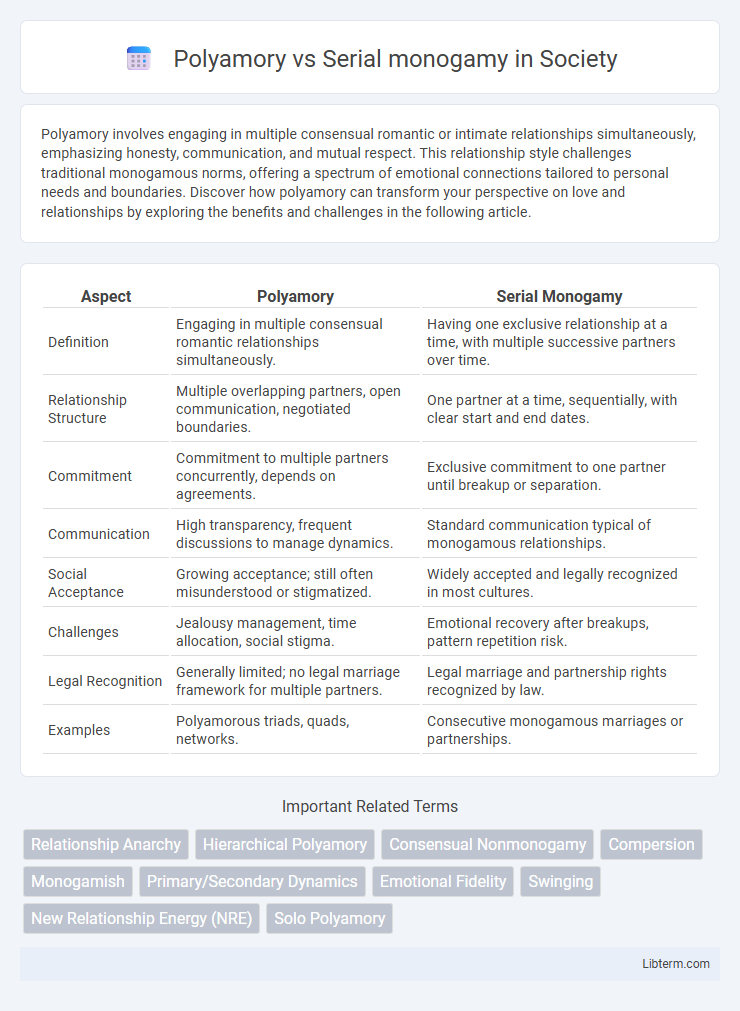Polyamory involves engaging in multiple consensual romantic or intimate relationships simultaneously, emphasizing honesty, communication, and mutual respect. This relationship style challenges traditional monogamous norms, offering a spectrum of emotional connections tailored to personal needs and boundaries. Discover how polyamory can transform your perspective on love and relationships by exploring the benefits and challenges in the following article.
Table of Comparison
| Aspect | Polyamory | Serial Monogamy |
|---|---|---|
| Definition | Engaging in multiple consensual romantic relationships simultaneously. | Having one exclusive relationship at a time, with multiple successive partners over time. |
| Relationship Structure | Multiple overlapping partners, open communication, negotiated boundaries. | One partner at a time, sequentially, with clear start and end dates. |
| Commitment | Commitment to multiple partners concurrently, depends on agreements. | Exclusive commitment to one partner until breakup or separation. |
| Communication | High transparency, frequent discussions to manage dynamics. | Standard communication typical of monogamous relationships. |
| Social Acceptance | Growing acceptance; still often misunderstood or stigmatized. | Widely accepted and legally recognized in most cultures. |
| Challenges | Jealousy management, time allocation, social stigma. | Emotional recovery after breakups, pattern repetition risk. |
| Legal Recognition | Generally limited; no legal marriage framework for multiple partners. | Legal marriage and partnership rights recognized by law. |
| Examples | Polyamorous triads, quads, networks. | Consecutive monogamous marriages or partnerships. |
Understanding Polyamory: Definition and Core Principles
Polyamory is defined as the practice of engaging in multiple consensual, romantic relationships simultaneously, emphasizing open communication, trust, and mutual respect among all partners. Core principles include honesty, transparency, autonomy, and the prioritization of emotional connections without exclusivity. Unlike serial monogamy, which involves sequential exclusive relationships, polyamory embraces parallel partnerships that foster shared growth and commitment within ethical boundaries.
Serial Monogamy: Meaning and Relationship Dynamics
Serial monogamy refers to engaging in a succession of exclusive, committed relationships, where an individual is monogamous with one partner at a time but enters new monogamous relationships after previous ones end. This relationship dynamic emphasizes emotional depth, trust, and exclusivity within each partnership, often allowing individuals to learn and grow through sequential experiences with different partners. Unlike polyamory, which involves multiple simultaneous romantic connections, serial monogamy maintains a clear boundary of singular commitment per relationship phase.
Key Differences Between Polyamory and Serial Monogamy
Polyamory involves maintaining multiple consensual and simultaneous romantic relationships, emphasizing openness and honest communication among all partners. Serial monogamy consists of engaging in one exclusive relationship at a time, sequentially ending one before beginning another, often guided by cultural norms about commitment and exclusivity. Key differences include the number of concurrent partners, relationship structure flexibility, and the level of transparency required between individuals.
Emotional Fulfillment: Comparing Both Approaches
Polyamory offers emotional fulfillment through multiple, overlapping romantic connections, allowing individuals to experience diverse sources of support, intimacy, and growth simultaneously. Serial monogamy provides emotional depth sequentially, focusing on exclusive, deep bonds that evolve over time but require ending previous relationships to move forward. Both approaches cater to different emotional needs: polyamory nurtures variety and constant connection, while serial monogamy emphasizes commitment and stability within singular partnerships.
Communication and Boundaries in Relationships
Effective communication and clearly defined boundaries are essential in both polyamory and serial monogamy to maintain trust and emotional well-being. In polyamorous relationships, open dialogue about needs, time management, and jealousy is crucial to navigate multiple partnerships harmoniously. Serial monogamy often requires communication focused on ending one relationship respectfully and establishing new boundaries before starting another, ensuring emotional closure and clarity.
Jealousy and Trust: Navigating Common Challenges
Polyamory requires open communication and established boundaries to manage jealousy, emphasizing trust through honesty and emotional transparency. Serial monogamy often deals with jealousy by resetting trust with each new partner, relying on clear expectations and past experiences to build confidence. Both relationship styles necessitate active emotional work to foster trust and mitigate jealousy for relationship stability.
Societal Perceptions and Stigmas
Societal perceptions of polyamory often include misconceptions of instability and moral judgment, contrasting with the widely accepted norm of serial monogamy, which is seen as a socially sanctioned pattern of consecutive exclusive relationships. Stigmas against polyamory can lead to discrimination and marginalization, while serial monogamy is largely normalized as a typical relational trajectory. Research indicates that societal acceptance heavily influences relationship satisfaction and mental health outcomes for individuals practicing either polyamory or serial monogamy.
Relationship Longevity and Satisfaction
Polyamory and serial monogamy offer distinct approaches to relationship longevity and satisfaction, with polyamory allowing multiple simultaneous romantic connections that can foster diverse emotional fulfillment and personal growth. Serial monogamy involves sequential exclusive relationships, which may provide clarity and stability but can also result in cyclical breakups and reunions, impacting long-term satisfaction. Studies indicate that satisfaction in polyamorous arrangements often correlates with effective communication and mutual consent, whereas serial monogamous individuals may prioritize commitment and exclusivity to enhance relational stability.
Legal and Ethical Considerations
Polyamory and serial monogamy present distinct legal and ethical challenges, with polyamory often lacking formal recognition in family law, affecting issues like marriage, custody, and inheritance rights. Serial monogamy aligns more closely with existing legal frameworks, as consecutive monogamous relationships are typically recognized, though ethical questions about transparency and commitment persist. Ethical considerations in polyamory emphasize consent and communication among multiple partners, while serial monogamy focuses on honesty and emotional closure between successive partners.
Choosing the Right Relationship Structure for You
Polyamory offers the opportunity to build multiple romantic relationships with transparency and mutual consent, emphasizing communication and emotional growth. Serial monogamy involves engaging in successive exclusive partnerships, allowing individuals to focus deeply on one connection at a time but with the potential for repeated breakups and new beginnings. Choosing the right relationship structure depends on personal values, emotional needs, and lifestyle preferences, with polyamory suiting those seeking diversity in intimacy and serial monogamy fitting those prioritizing exclusivity and stability.
Polyamory Infographic

 libterm.com
libterm.com